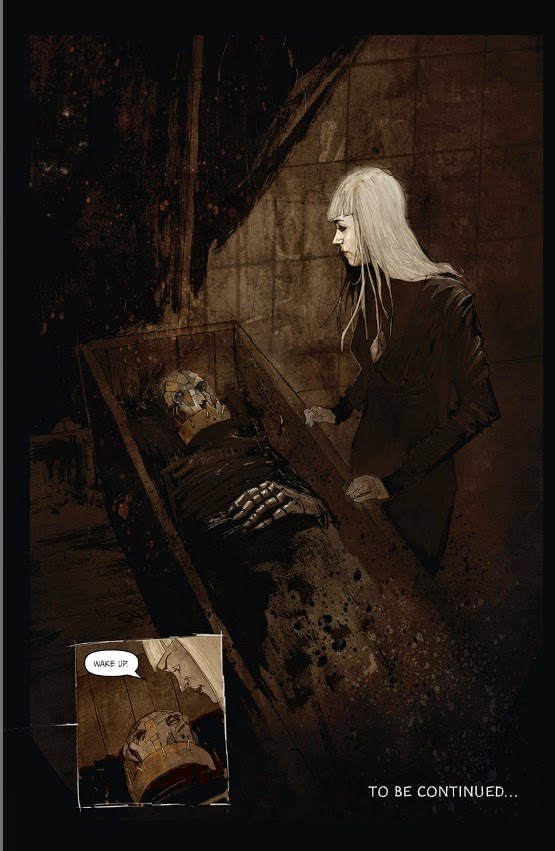My first impression reading through this book was that it seems to be a dark mixture of the Adam’s family, the Sopranos family, and the Winchester family, presented as a comic. To summarise this first issue, readers are introduced to the macabre and dysfunctional Allan
family one by one. The story starts out slowly, introducing character-based
subplots and small intrigues that all seem to be leading up to a real conflict. The first scene, a conversation between Geoff Allan and an old high school bully, is slow paced and small-time. It provides a contrast to the
extensive episode between Geoff's father Frederick Allan and his old monster-hunting comrade. Other forms of contrast play a big part of this book's creation.
 The dark, impressionist style of Damien Worm's artwork in this book tends to overwhelm the writing of Steve Niles for the most part; the art carries the story along and would work even without the text. It appears to be made up of watercolour paintings, with an
intriguing manipulation of colour that serves to help the comic’s dark and strange meaning come
across. The images also manage to sustain a balance between colour and darkness,
with changes between panels bringing them out of any frozen state that they might have otherwise slipped into. This also works to set the comic’s tone.
The dark, impressionist style of Damien Worm's artwork in this book tends to overwhelm the writing of Steve Niles for the most part; the art carries the story along and would work even without the text. It appears to be made up of watercolour paintings, with an
intriguing manipulation of colour that serves to help the comic’s dark and strange meaning come
across. The images also manage to sustain a balance between colour and darkness,
with changes between panels bringing them out of any frozen state that they might have otherwise slipped into. This also works to set the comic’s tone.
The comic starts with a mainly dark and earthly colour palette until anger is introduced, as the bullying Phil character's hair seems to become fire, followed by the shocking red panel depicting a car accident flashback.
 It is an interesting comparison to consider the later
flashbacks in the comic, those of the father’s life hunting monsters, are not coloured like the car crash; they appear in pale grey tones. This is in spite of the fact that a lot of action and violence is depicted in Frederick's past that would resemble a car crash scene. This contrast may contribute to the reader's notion of the Allan family dynamic, and at the very least ensures that Geoff and Frederick are viewed as starkly different characters despite being father and son.
It is an interesting comparison to consider the later
flashbacks in the comic, those of the father’s life hunting monsters, are not coloured like the car crash; they appear in pale grey tones. This is in spite of the fact that a lot of action and violence is depicted in Frederick's past that would resemble a car crash scene. This contrast may contribute to the reader's notion of the Allan family dynamic, and at the very least ensures that Geoff and Frederick are viewed as starkly different characters despite being father and son. Another notable artistic choice appears in the scene that introduces the daughter Vivian Allan as a character. The first page shows her own encounter with bullies. The faces in Vivian's vision of the future of these girls are almost caricatures, warped and horrific in comparison to their "present" appearances and other faces in the comic. In this case, there is less contrast between Vivian and her brother (who sees the ghosts of the people in the car crash in a similar style) and it is obvious even before we see brother and sister together that the two are quite close.
Another notable artistic choice appears in the scene that introduces the daughter Vivian Allan as a character. The first page shows her own encounter with bullies. The faces in Vivian's vision of the future of these girls are almost caricatures, warped and horrific in comparison to their "present" appearances and other faces in the comic. In this case, there is less contrast between Vivian and her brother (who sees the ghosts of the people in the car crash in a similar style) and it is obvious even before we see brother and sister together that the two are quite close.
The black gutters surround the panels with a bleak
transtextuality, which may emphasize the reader’s feeling of being closed in, intrigued by mystery, lost in a demented, supernatural world. Worm plays heavily with gutter thickness, panel edging, sometimes crowding the pages with images and sometimes leaving them seem
hauntingly empty. Other times, the panel art leaks into the gutters, or splatters messily as with a scene involving Frederick.
In
addition to this, the comic employs some intertextuality in a large panel that
draws attention to various fictional “monsters" that we are more used to.
The story itself is mostly linear, again with the heavy employment of
flashbacks that may contribute to a future plot, but are more obviously meant to help characterise
the family members that are introduced in this issue. The effort that has been put
into characterising certain family members and their peculiarities provides another contrast to the
many mysteries that remain. In particular, there is the mystery of Deloris Allan, the mother who exhibits blatantly
suspicious behaviour and draws the attention of Frederick's retired monster-hunting friend. The final page provides the most
suspense in this issue, after readers are hopefully invested enough in the intense Allan family, they're left with a sinister scene and those last horrible three words.
"To be continued..."
Amber Dilabbio



No comments:
Post a Comment